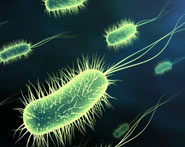


 النبات
النبات
 الحيوان
الحيوان
 الأحياء المجهرية
الأحياء المجهرية
 علم الأمراض
علم الأمراض
 التقانة الإحيائية
التقانة الإحيائية
 التقنية الحيوية المكروبية
التقنية الحيوية المكروبية
 التقنية الحياتية النانوية
التقنية الحياتية النانوية
 علم الأجنة
علم الأجنة
 الأحياء الجزيئي
الأحياء الجزيئي
 علم وظائف الأعضاء
علم وظائف الأعضاء
 الغدد
الغدد
 المضادات الحيوية
المضادات الحيوية|
Read More
Date: 20-12-2015
Date: 14-3-2021
Date: 20-11-2020
|
Anomalous Dispersion
If an atom is hit by an X-ray beam, as in X-ray crystallography, it scatters the beam in all directions. The scattered radiation can have the same wavelength as the primary beam (Rayleigh or coherent or elastic scattering) or a longer wavelength (Compton or incoherent or inelastic scattering). For diffraction, only the coherent part of the scattering is of interest. Incoherent scattering simply increases the background.
Electrons in an atom are bound by the nucleus and are, in principle, not free electrons. However, they can be regarded as such if the frequency of the incident radiation w is large compared with the natural absorption frequencies wn of the scattering atom, or if the wavelength of the incident radiation is short compared with the absorption edge wavelength. This is normally true for the light atoms but not for the heavy atoms (Table 1).
Table 1. The Position of the Ka-Edge for Some Elements

If the electrons in an atom are regarded as free electrons, the atomic scattering amplitude (atomic scattering factor in units of electron scattering) is a real quantity f because the electron cloud is centrosymmetric. If they are not free electrons, the atomic scattering factor becomes an imaginary quantity, the scattering amplitude per electron:

where E0 is the amplitude of the electric vector of the incident beam, and kn is a damping factor for the nth orbit (K or L or ¼). For w > wn, Eq. (1) approaches f = E0e2/mc2, the scattering amplitude of a free electron (1-3).
In practice, the complex atomic scattering factor, called fanomalous, is separated into three parts: fanomalous = f + f′ + if′′. f is the contribution to the scattering if the electrons were free electrons, f′ is the real part of the correction to be applied for non-free electrons, and f′′ is the imaginary correction. f + f′ is the total real part of the atomic scattering factor. Values for f, f′ , and f′′ are always given in units equal to the scattering by one free electron and are listed in Ref. 3. Because the anomalous contribution to the atomic scattering factor is mainly due to the electrons close to the nucleus, the value of the correction factors diminishes slowly as a function of the scattering angle, slower than for f.
Anomalous scattering causes a violation of Friedel's law: I(h k e ) is no longer equal to I(h k e ). This fact can be used profitably for determining the absolute configuration (4). Moreover, it can assist in the structural determination of proteins.
References
1. R. W. James (1965) The Optical Principles of the Diffraction of X-rays, G. Bell and Sons, London, p. 135.
2. H. Hönl (1933) Ann. der Physik, 5. Folge 18, 625–655.
3. International Union of Crystallography (1995) International Tables for Crystallography, Vol. C (A. J. C. Wilson, ed.), Kluwer Academic Dordrecht, Boston, London.
4. J. M. Bijvoet, A. F. Peerdeman, and A. J. van Bommel (1951) Nature 168, 271–271.



|
|
|
|
للتخلص من الإمساك.. فاكهة واحدة لها مفعول سحري
|
|
|
|
|
|
|
العلماء ينجحون لأول مرة في إنشاء حبل شوكي بشري وظيفي في المختبر
|
|
|
|
|
|
|
قسم العلاقات العامّة ينظّم برنامجاً ثقافياً لوفد من أكاديمية العميد لرعاية المواهب
|
|
|